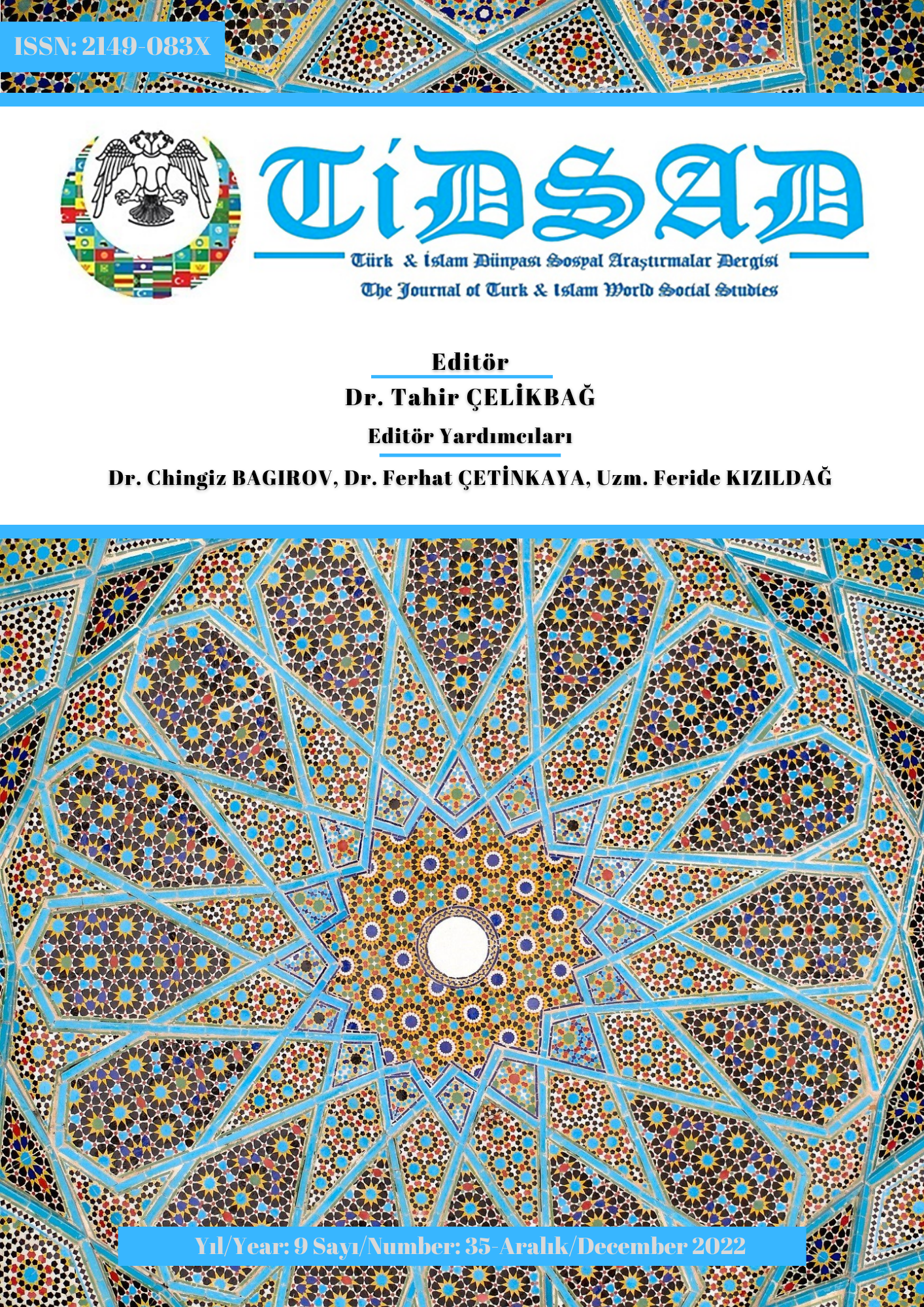Author :
Abstract
Uzaktan eğitim, çeşitli kitle iletişim araçlarıyla uygulandığı uzun bir geçmişe sahip olsa da pandemi döneminde gerçek anlamda altın çağını yaşamış ve tüm dünyaya hızlı bir şekilde yayılmıştır. Okulların kapalı olduğu uzaktan eğitim döneminde öğrenci ve öğretmenler derslerin büyük çoğunluğunu teknolojinin yardımıyla yürütmüşler; internet üzerinden çeşitli platformlar ya da uygulamalar kullanmışlardır. Bu dönemde öğrenci ve öğretmenlerin edindiği bazı deneyimler okulların açılması ve yüz yüze eğitime geçilmesinden sonra da devam etmiştir. Bu deneyimlerden en önemlisi eğitimde teknoloji kullanımıdır. Uzaktan eğitimden sonra da derslere destek olan birçok eğitsel mobil uygulamanın kullanımı devam etmiştir. Dil eğitiminde ise mobil eğitsel uygulama sayısı gün geçtikçe artmaktadır. Bu uygulamaların içerik ve kullanışlılık bakımından analiz edilmesi gerekmektedir. Ayrıca dil eğitiminde kullanılan eğitsel mobil uygulamaların önemli bir hedefi olan kelime öğretimi açısından yeterliliklerinin incelenmesi önem arz etmektedir. Bu çalışmada dil eğitiminde kullanılan eğitsel mobil uygulamaların özellikleri ve dil eğitimine olan etkisi ile ilgili ülkemiz ve dünyada yapılan çalışmalar araştırılmıştır. Daha sonra ülkemiz açısından hem dini hem de sosyal olarak önemini her dönem koruyan Arap dili çalışmaları araştırılmış; Arapça öğretiminde mobil cihazlara en çok indirilen ve en çok beğenilen uygulamalardan biri olan ‘Learn Arabic’ uygulaması içerik ve özellikleri bakımından incelenmiştir. Bu uygulamanın bölümleri, içeriği, kullanışlılığı kelime öğretimi açısından incelenmiş ve yorumlanmıştır.
Keywords
Abstract
Although distance education has a long history of being implemented with various mass media, it truly experienced its golden age during the pandemic period and spread rapidly all over the world. During the distance education period when schools were closed, students and teachers conducted most of the lessons with the help of technology; they used various platforms or applications over the internet. Some of the experiences gained by students and teachers in this period continued after the opening of schools and the transition to face-to-face education. The most important of these experiences is the use of technology in education. After the distance education, the use of many educational mobile applications that support the lessons continued. In language education, the number of mobile educational applications is increasing day by day. These applications need to be analyzed in terms of content and usability. In addition, it is important to examine the proficiency of the educational mobile applications used in language education in terms of vocabulary teaching and their effects on users. In this study, the features of educational mobile applications used in language education and their effects on language education were investigated in our country and in the world. Later on, Arabic language studies, which have always maintained their importance both religiously and socially for our country, were researched. After that 'Learn Arabic' application, which is one of the most downloaded and most admired applications in teaching Arabic, has been examined in terms of its content and features. The parts, content and usefulness of this application were examined and interpreted in terms of teaching vocabulary.
Keywords
- Abdüsselam, M. S. (2019). Arapça yazma becerisinin desteklenmesine yönelik artı- rılmış gerçeklik teknolojisinin kullanımı. In Proceedings Book 7th International Conference on Instructional Technology and Teacher Education (Vol. 635, p. 641).
- Başoğlu, E. B., ve Akdemir, O. (2010). A comparison of undergraduate students' English vocabulary learning: Using mobile phones and flash cards. Turkish Online Journal of Educational Technology-TOJET, 9(3), 1-7p. https://eric.ed.gov/?id=EJ898010 sayfasından erişilmiştir.
- Büyüköztürk, Ş., Kılıç-Çakmak, E., Akgün, Ö., Karadeniz, Ş., & Demirel, F. (2008). Bilimsel araştırma yöntemleri. Pegem Akademi
- Can, E. (2020). Coronavirüs (Covid-19) pandemisi ve pedagojik yansımaları: Tür- kiye’de açık ve uzaktan eğitim uygulamaları. Açıköğretim Uygulamaları ve Araştırmaları Dergisi AUAd. 6(2), 11-53.
- Castañeda, D. A., Cho, M-H. (2016) Use of a game-like application on a mobile devi- ce to improve accuracy in conjugating Spanish verbs, Computer Assisted Language Learning, 29:7, 1195-1204, http://dx.doi.org/10.1080/09588221.2016.1197950
- İşman, A. (2022). Uzaktan eğitim. Ankara: Pegem Akademi. http://dx.doi.org/10.14527/9789758792822
- Karkar, A., Alja'Am, J. M., Eid, M., & Sleptchenko, A. (2015). E-learnıng mobıle applı- catıon for arabıc learners. Journal of Educational & Instructional Studies in the World, 5(2).
- Kurt, M., and Bensen, H. (2017). Six seconds to visualize the word: improving EFL learners' vocabulary through VVVs. Journal of Computer Assisted Learning, 33(4),334-346p. https://doi.org/10.1111/jcal.12182
- Neri, A., Mich, O., Gerosa, M., & Giuliani, D. (2008). The effectiveness of computer assisted pronunciation training for foreign language learning by children. Computer Assisted Language Learning, 21(5), 393-408. https://doi.org/10.1177/0033688220977406
- Nushi, M., Eqbali, M. H. (2017). Duolıngo: a mobile application to assist second lan- guage learning (App Review). Teaching English with Technology 1:89-98. https://www.ceeol.com/search/article-detail?id=478437 adresinden erişilmiştir.
- OECD (2021). The state of global education 18 months into the pandemic. https://www.oecd-ilibrary.org/education/the-state-of-globaleducation_1a23bb23-en sayfasından erişilmiştir.
- Rosell-Aguilar, F. (2018) Autonomous language learning through a mobile applica- tion: a user evaluation of the busuu app, Computer Assisted Language Learning, 31:8, 854-881, http://dx.doi.org/10.1080/09588221.2018.1456465
- Saran, M., Cagiltay, K., ve Seferoglu, G. (2008, Mart). Use of mobile phones in langu- age learning: Developing effective instructional materials. In Fifth IEEE International Conference on Wireless, Mobile, and Ubiquitous Technology in Education (wmute 2008), 39-43s. IEEE. https://ieeexplore.ieee.org/stamp/stamp.jsp?tp=&arnumber=4489786 sayfasından erişilmiştir.
- Thornton, P., & Houser, C. (2005). Using mobile phones in English education in Ja- pan. Journal of computer assisted learning, 21(3), 217-228. https://doi.org/10.1111/j.1365-2729.2005.00129.x
- Uygun, D. (2022) Çocuklarda yabancı dil öğretiminde mevcut mobil uygulama kul- lanımının ilkokul 4. Sınıf öğrencilerinin İngilizce ders başarılarına etkileri. Basılmamış Doktora Tezi. Eskişehir Anadolu Üniversitesi Sosyal Bilimler Enstitüsü.
- Vesselinov, R., Grego, J., Tasseva-Kurktchieva, M., Sedaghatgoftar, N. (2016). The busuu efficacy study. http://comparelanguageapps.com/documentation/The_busuu_Study2016. pdf sayfasından erişilmiştir.
- WHO, 2020 Listings of WHO’s response to COVID-19 https://www.who.int/news/item/29-06-2020-covidtimeline#cms sayfasından 05.11.2022 tarihinde erişilmiştir.
- Yaman, G. Ş. (2016). Yabancı dil olarak Arapça öğretiminde WhatsApp kullanımı. Uluslararası Güncel Eğitim Araştırmaları Dergisi, 2(1), 37-47. https://dergipark.org.tr/en/download/article-file/237466 sayfasından eri
- Yaman, B. (2021). Covid-19 pandemisi sürecinde Türkiye ve Çin’de uzaktan eğitim süreç ve uygulamalarının incelenmesi. OPUS International Journal of Society Researches, 17(Pandemi Özel Sayısı), 3298-3308.
